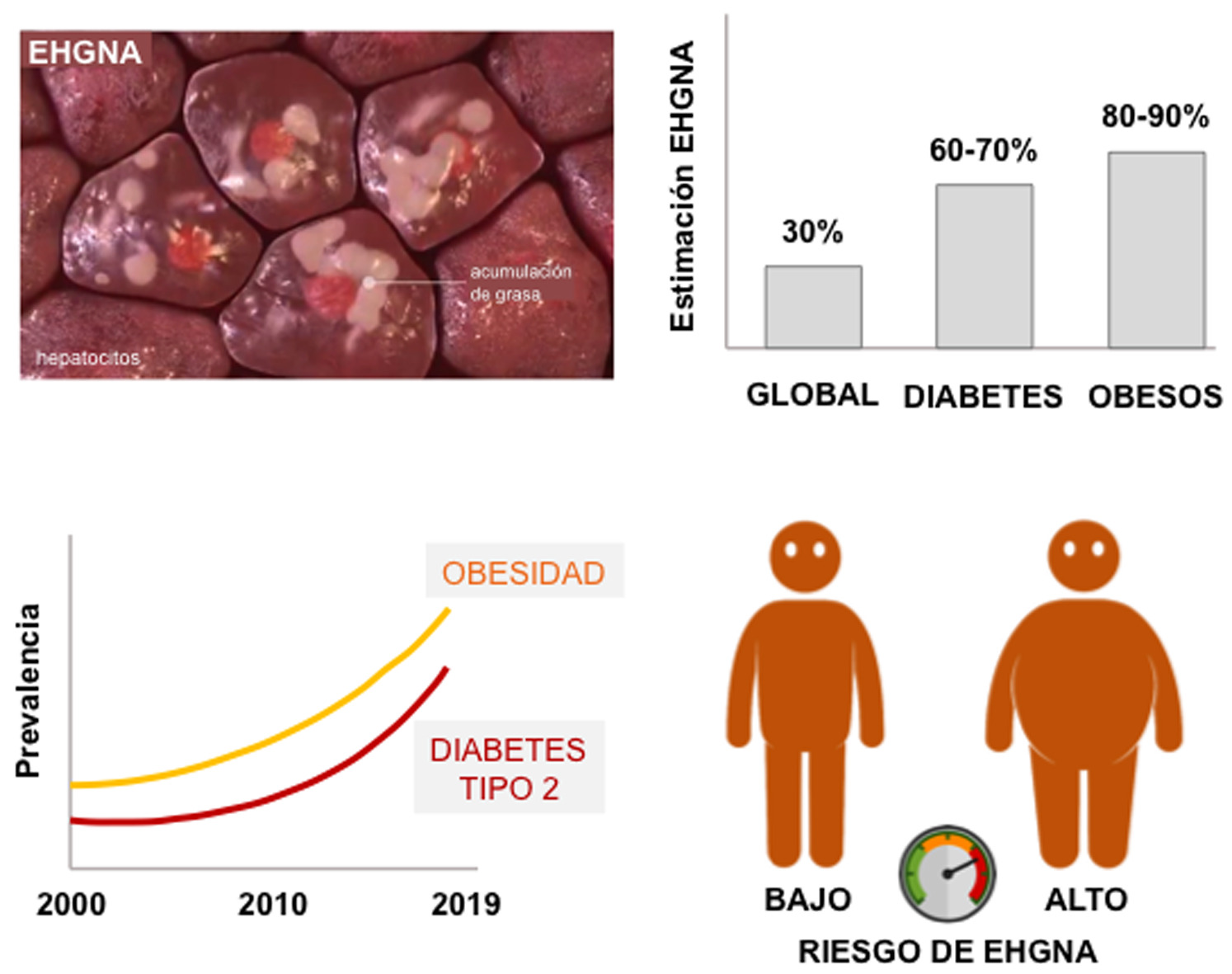Serum metabolomic analysis for detecting preneoplastic liver damage in people with age-increased fragility

REPORT 1: “State of knowledge about the topic”
Introduction
The modern lifestyle of frequent consumption of high calorie diets and little physical activity is responsible for the appearance of a silent disease whose main characteristic is the excessive accumulation of fat in the liver (Figure 1). When it is not associated with high alcohol consumption, it is known as non-alcoholic fatty liver disease (NASH).

Figure 1. Representation of fat accumulation in hepatocytes in patients with non-alcoholic fatty liver disease (NASH). Estimation of the prevalence in the global population, in individuals with diabetes and in obese people. Evolution of the prevalence of NASH in the last 20 years in obese patients and in patients with type 2 diabetes. Risk of NASH in the population as a function of body weight.
It is estimated that this disease affects one third of the world's population, both young and old. It is slightly more common in men than women and in older people, as more complications tend to occur.
When the non-alcoholic fatty liver is chronically maintained, it can evolve into a more severe state of inflammation and cell death, which is called non-alcoholic steatohepatitis. This more acute form of the disease is considered one of the major challenges for the 21st century health system, as there is an increasing number of people with overweight/obesity or type 2 diabetes who are most at risk of the disease evolving into a more severe phase of more severe damage with cirrhosis (Figure 2) and are also most at risk of cardiovascular disease.

Figure 2. When the accumulation of fat in the liver cells exceeds 5%, it is referred to as non-alcoholic fatty liver disease (NASH). If the situation continues, there is inflammation and cell damage (nonalcoholic steatohepatitis) and scars begin to form. The presence of these scars (cirrhosis) is the reason of the liver not performing correctly and is also a risk factor for the development of liver cancer.
As it is a silent disease, many patients are unaware that they have a damaged liver. They are often diagnosed in an advanced stage when the damage is irreversible, with cirrhosis or even liver cancer. The only curative treatment is a transplant, which is not always possible and has a high cost, so in the coming years it is expected that this disease will place an economic burden on national health systems.
Several clinical trials are currently underway to investigate the efficacy and safety of new drugs that slow down the progression of the disease towards an irreversible damage. A research on early detection of liver damage is also being conducted.
The most common liver cancer is hepatocellular carcinoma (HCC), followed by cholangiocarcinoma (CCA). Both types of tumors are usually diagnosed in people over 60 years of age and are usually detected in advanced stages, when surgical removal is no longer possible. They are characterized by high refractoriness to chemotherapy and poor prognosis. Overall, 5-year survival ranges from 10 to 40 percent. In relation to APC, it is a very aggressive type of tumour with a poor prognosis. When patients notice the symptoms, usually it is already in a very advanced stage when there are little chances of being cured. The fact that it is infrequent justifies that the results have been slower than in other types of cancer but, thanks to international collaboration, some progress is being made.
Currently there are no non-invasive, specific and sensitive biomarkers that allow early diagnosis in patients at risk of developing these tumors, such as people with cirrhosis, and other chronic liver diseases. Various studies are looking for markers analyzing biological fluids: circulating DNA extracellular vesicles, which are vesicles that are released from the cells and may contain specific characteristics of the tumor cells or proteins that can appear altered in tumors. Attempts are also being made to detect the own tumor cells in the blood.
In a recent study conducted on a small number of patients with HCC, iCCA and on control subjects, which has just been accepted in the journal Hepatology (https://www.ncbi.nlm.nih.gov/pubmed/30325540), several metabolites with low molecular weight have been identified. They present better diagnostic capacity than the serum markers currently used in the clinic to help diagnose these tumors, alpha-fetoprotein (AFP) and carbohydrate antigen 19-9 (CA 19-9), for HCC and CCA, respectively.
Objective
This project aims to conduct a validation study focused on elderly people to analyze the usefulness of these biomarkers in the detection of neoplastic lesions in a particularly fragile population, in which the early detection is vital.
Methodology
To carry out this study, serum samples from patients with HCC, CCA and liver grade will be used at different stages of the disease, with different age ranges (over 65 years old) and from healthy subjects (control). From the serum the metabolites will be analyzed by means of a device (HPLC-MS/MS) that allows to detect and quantify each one of them and to determine which ones are altered. This could serve to detect each type of disease and to distinguish them.
References:
- Adams LA. Mini-review: end-points for drug treatment in NASH. Hepatol Int. 2019 doi: 10.1007/s12072-019-09935-6.
- Banales JM, Iñarrairaegui M, Arbelaiz A, Milkiewicz P, Muntané J, Muñoz-Bellvis L, La Casta A, Gonzalez LM, Arretxe E, Alonso C, Martínez-Arranz I, Lapitz A, Santos-Laso A, Avila MA, Martínez-Chantar ML, Bujanda L, Marin JJG, Sangro B, Macias RIR. Serum Metabolites as Diagnostic Biomarkers for Cholangiocarcinoma, Hepatocellular Carcinoma, and Primary Sclerosing Cholangitis. Hepatology 2019 doi: 10.1002/hep.30319
- Castera L, Friedrich-Rust M, Loomba R. Non-Invasive assessment of liver disease in Patients with NAFLD. Gastroenterology 2019 doi: 10.1053/j.gastro.2018.12.036.
- Macias RI, Banales JM, Sangro B, Muntané J, Avila MA, Lozano E, Perugorria MJ, Padillo FJ,
Bujanda L, Marin JJG. The search for novel diagnostic and prognostic biomarkers in cholangiocarcinoma. Biochim Biophys Acta 2018; 1864: 1468-1477.
- Macias RIR, Kornek M, Rodrigues PM, Paiva NA, Castro RE, Urban S, Pereira SP, Cadamuro M, Rupp C, Loosen SH, Luedde T, Banales JM. Diagnostic and prognostic biomarkers in cholangiocarcinoma. Liver Int (in press).







